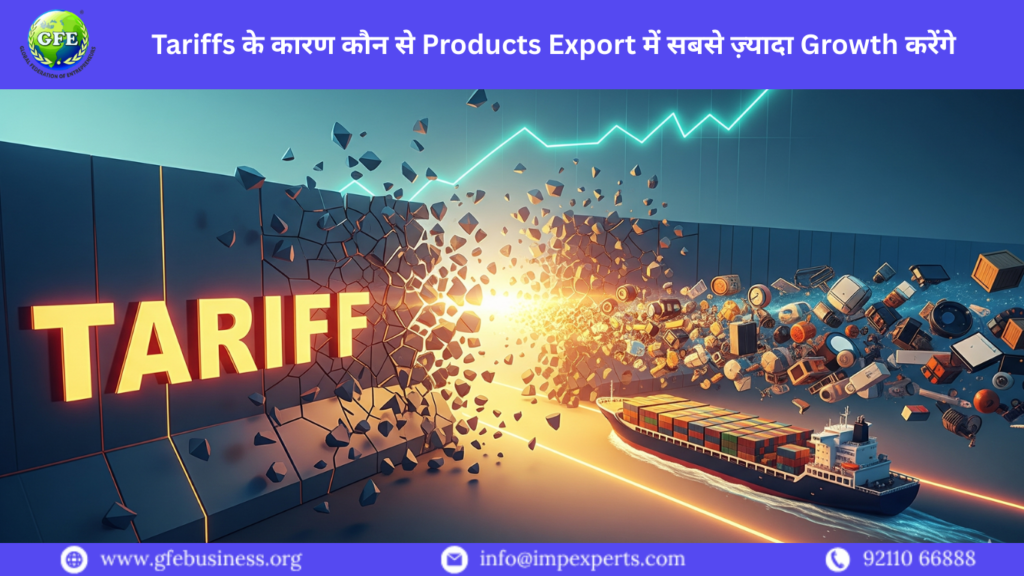Global trade policies, especially tariffs, have a direct impact on which products grow fastest in export markets. With U.S. and other major economies imposing high tariffs on certain countries—especially China—Indian exporters now have a strategic opportunity to capture displaced demand.
Exporters who understand these shifts and prepare with compliance, documentation, and market research can gain significant growth. Platforms like GFE Business help exporters anticipate tariffs, optimize pricing, and ensure smooth shipment to international markets.
In this guide, we’ll explore:
Which products are seeing the highest growth due to global tariffs
Sector-wise analysis and opportunity hotspots
Strategies to enter high-growth export segments
Mini case studies and actionable checklists
Why Tariffs Create Export Growth Opportunities
Tariffs increase the landed cost of goods from targeted countries, prompting buyers to:
Switch suppliers – U.S. and European buyers look for alternatives
Pay premium for reliable sources – quality and compliance become differentiators
Expand sourcing diversity – reducing dependency on one country
For Indian exporters, this means products previously overshadowed by China or other high-tariff countries are now in demand.
Top Export Products with Growth Potential
1. Textiles & Apparel
Why growth:
U.S. and EU have high tariffs on Chinese cotton and synthetic garments
Indian manufacturers from Surat, Tiruppur, and Ludhiana can offer competitive quality at better compliance
Pro tips:
Focus on value-added garments (embroidered, branded, premium fabrics)
Ensure certifications and documentation are accurate
Maintain reliable shipping schedules
Mini Case Study:
A Tiruppur knitwear SME captured new U.S. orders worth $2M by offering high-quality cotton garments with proper HS codes and COO documentation.
2. Pharmaceuticals & APIs
Why growth:
China dominates generic APIs, but tariffs have raised costs for U.S. buyers
India can supply FDA-approved generics, specialty drugs, and APIs
Pro tips:
Ensure regulatory approvals (FDA, cGMP)
Use digital compliance checklists to avoid shipment delays
Mini Case Study:
A Hyderabad pharma company pivoted to U.S. generics previously sourced from China, increasing revenue by 35% in one year.
3. Gems & Jewellery
Why growth:
Chinese jewellery imports face high tariffs in key markets
Indian diamonds, gold jewellery, and certified products become attractive alternatives
Pro tips:
Emphasize certifications like RJC or hallmark
Provide complete documentation (COO, FTA certificates)
Mini Case Study:
A Surat diamond polishing unit expanded exports by 50% after entering U.S. and European markets affected by tariffs on Chinese imports.
4. Seafood & Shrimp
Why growth:
High tariffs on Chinese shrimp make Indian exports more competitive
Sustainability certifications increase market access
Pro tips:
Invest in HACCP and cold-chain infrastructure
Target premium buyers willing to pay for certified quality
Mini Case Study:
A Gujarat-based shrimp exporter increased U.S. shipments by 60% after enhancing quality and ensuring certification compliance.
5. Engineering Goods & Auto Components
Why growth:
China faces 30–50% tariffs on machinery and auto parts
India can supply mid-tier machinery, parts, and components to U.S. and EU markets
Pro tips:
Ensure product standards match buyer requirements
Offer value-added services like assembly or packaging
Mini Case Study:
An Indian auto component SME captured contracts previously held by Chinese suppliers, increasing annual revenue by $3M.
Actionable Strategies for Export Growth
Market Intelligence: Track tariffs and identify high-opportunity countries
Compliance Readiness: Certifications, HS codes, COO, and FTA documentation must be accurate
Value Addition: Premium packaging, branding, and product differentiation increase buyer preference
Government Support: Use RoDTEP, EPCG, and PLI schemes to offset costs
Training & Resources: Platforms like GFE Business provide step-by-step guidance for high-growth export products
Checklist: Products Ready for Growth
Identify tariff-impacted markets
Validate HS codes and product classification
Obtain necessary certifications (FDA, HACCP, ISO, RJC)
Ensure COO and FTA documentation are accurate
Map logistics and shipping costs
Price for margins including duties and tariffs
Conclusion
Tariffs don’t just create challenges—they highlight opportunities. Indian exporters who act strategically can:
Capture market share lost by high-tariff countries
Increase profitability with the right pricing and compliance
Build long-term international partnerships
Bottom line: Jo exporters जल्दी adapt करेंगे और सही products target करेंगे, वही maximum growth पाएंगे. With proper training, documentation, and market intelligence, Indian SMEs can turn global tariff disruption into export success.
Ready to learn which products can maximize your export growth?
Get practical guidance and expert-led training at 👉 GFE Business








